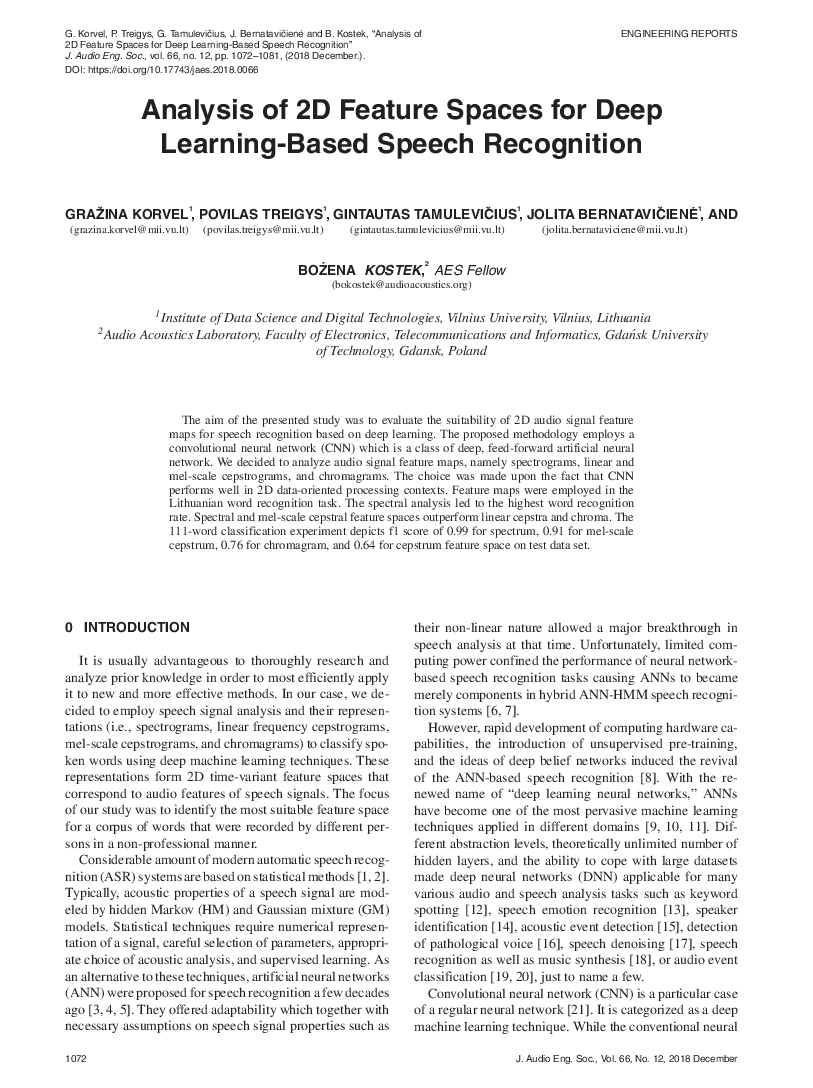Home / Publications / E-library page
You are currently logged in as an
Institutional Subscriber.
If you would like to logout,
please click on the button below.
Home / Publications / E-library page
Only AES members and Institutional Journal Subscribers can download
The aim of this study was to evaluate the suitability of 2D audio signal feature maps for speech recognition based on deep learning. The proposed methodology employs a convolutional neural network (CNN), which is a class of deep, feed-forward artificial neural network. The authors analyzed the audio signal feature maps, namely spectrograms, linear and Mel-scale cepstrograms, and chromagrams. This choice was made because CNN performs well in 2D data-oriented processing contexts. Feature maps were employed in a Lithuanian word-recognition task. The spectral analysis led to the highest word recognition rate. Spectral and mel-scale cepstral feature spaces outperform linear cepstra and chroma. The 111-word classification experiment depicts f1 score of 0.99 for spectrum, 0.91 for mel-scale cepstrum , 0.76 for chromagram, and 0.64 for cepstrum feature space on test data set.
Author (s): Korvel, Gražina; Treigys, Povilas; Tamulevicus, Gintautas; Bernataviciene, Jolita; Kostek, Bozena
Affiliation:
Institute of Data Science and Digital Technologies, Vilnius University, Vilnius, Lithuania; Audio Acoustics Laboratory, Faculty of Electronics, Telecommunications and Informatics, Gdansk University of Technology, Gdansk, Poland
(See document for exact affiliation information.)
Publication Date:
2018-12-06
Import into BibTeX
Permalink: https://aes2.org/publications/elibrary-page/?id=19880
(201KB)
Click to purchase paper as a non-member or login as an AES member. If your company or school subscribes to the E-Library then switch to the institutional version. If you are not an AES member Join the AES. If you need to check your member status, login to the Member Portal.

Korvel, Gražina; Treigys, Povilas; Tamulevicus, Gintautas; Bernataviciene, Jolita; Kostek, Bozena; 2018; Analysis of 2D Feature Spaces for Deep Learning-Based Speech Recognition [PDF]; Institute of Data Science and Digital Technologies, Vilnius University, Vilnius, Lithuania; Audio Acoustics Laboratory, Faculty of Electronics, Telecommunications and Informatics, Gdansk University of Technology, Gdansk, Poland; Paper ; Available from: https://aes2.org/publications/elibrary-page/?id=19880
Korvel, Gražina; Treigys, Povilas; Tamulevicus, Gintautas; Bernataviciene, Jolita; Kostek, Bozena; Analysis of 2D Feature Spaces for Deep Learning-Based Speech Recognition [PDF]; Institute of Data Science and Digital Technologies, Vilnius University, Vilnius, Lithuania; Audio Acoustics Laboratory, Faculty of Electronics, Telecommunications and Informatics, Gdansk University of Technology, Gdansk, Poland; Paper ; 2018 Available: https://aes2.org/publications/elibrary-page/?id=19880
@article{korvel2018analysis,
author={korvel gražina and treigys povilas and tamulevicus gintautas and bernataviciene jolita and kostek bozena},
journal={journal of the audio engineering society},
title={analysis of 2d feature spaces for deep learning-based speech recognition},
year={2018},
volume={66},
issue={12},
pages={1072-1081},
month={december},}
TY – paper
TI – Analysis of 2D Feature Spaces for Deep Learning-Based Speech Recognition
SP – 1072 EP – 1081
AU – Korvel, Gražina
AU – Treigys, Povilas
AU – Tamulevicus, Gintautas
AU – Bernataviciene, Jolita
AU – Kostek, Bozena
PY – 2018
JO – Journal of the Audio Engineering Society
VO – 66
IS – 12
Y1 – December 2018